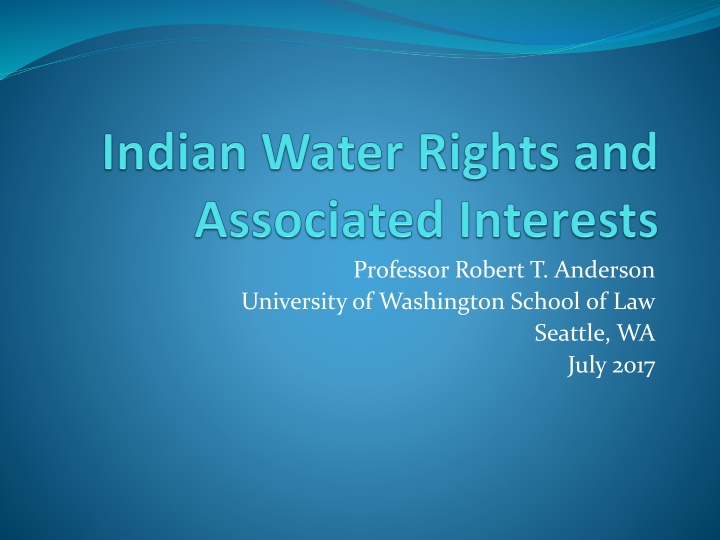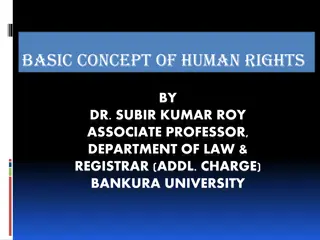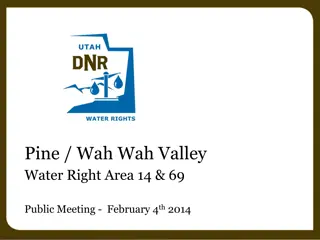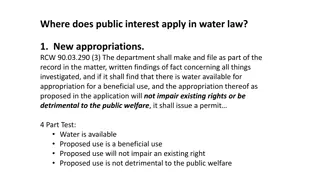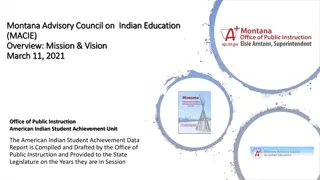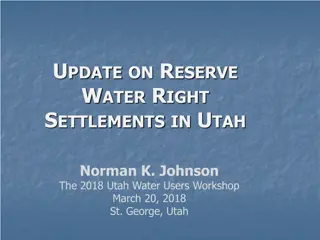Overview of Indian Water Rights Rooted in Federal Law
Indian water rights are deeply rooted in federal law, including principles such as aboriginal title and treaties. The conflicts between Indian and non-Indian rights have led to lengthy litigations and settlements. From common law roots to state water laws, the historical development of water rights in the Western States is complex and influenced by prior appropriation principles. An examination of cases such as United States v. Winans and Winters v. United States sheds light on the legal framework surrounding Indian reserved water rights.
Download Presentation

Please find below an Image/Link to download the presentation.
The content on the website is provided AS IS for your information and personal use only. It may not be sold, licensed, or shared on other websites without obtaining consent from the author.If you encounter any issues during the download, it is possible that the publisher has removed the file from their server.
You are allowed to download the files provided on this website for personal or commercial use, subject to the condition that they are used lawfully. All files are the property of their respective owners.
The content on the website is provided AS IS for your information and personal use only. It may not be sold, licensed, or shared on other websites without obtaining consent from the author.
E N D
Presentation Transcript
Professor Robert T. Anderson University of Washington School of Law Seattle, WA July 2017
Overview Indian water rights rooted in federal law, including aboriginal title as recognized in U.S. Deep conflicts between Indian and non-Indian rights Indian treaties, agreements, statutes and Executive Orders at foundation of tribal water rights Expensive and lengthy litigation; settlements
Common Law Roots to Codes Mining camp rules for mining claims applied to water used in those camps under territorial and state law Chaotic in terms of record keeping and notice to others Wyoming adopts first water code in 1890; Alaska in 1966
State Water Law Western States Water allocated according to prior appropriation Water availability determination (theoretical) First in time is first in right Beneficial use Productive purpose Use it or lose it Reasonable efficiency Public interest Little enforcement
Water to Fulfill Indian Treaties Indian reserved water rights are based on federal law Winters doctrine: associated with establishment of Indian reservations for agricultural purposes Aboriginal water claims for instream flows, sometimes called Winans rights Spanish law (to 1821) or Mexican law (to 1846) (Pueblos)
Winans -- Rules Implied easement to cross non-Indian land to reach usual and accustomed stations State may not defeat right by authorizing non-Indian fishing with wheel Creation of State has no effect on federal rights reserved by treaty
Winters v. United States (1908) Indian reservation in 1888 established for agricultural purposes State appropriators precede Indian use, but after 1888 Court implies reserved Indian rights as of the date of the reservation 1888 --- to fulfill agricultural purposes of the reservation
Winters v. U.S.: Non-Indian water use for irrigation precedes Indian use Non-Indians Milk River Fort Belknap Res.
Post-Winters Developments Open-ended court decrees (lack of certainty) Allotment water rights and transferability recognized (U.S. v. Powers 1939) Extensive non-Indian development through BOR; Tribal rights ignored U.S. has very poor record in developing and protecting Indian water up until the 1970s
Arizona v. California (1963) Water rights litigation over agricultural reservations along Colorado River Sufficient water reserved to meet present and future needs of the reservation Practicably irrigable acreage (PIA) is the measure for land not historically irrigated
Nevada Lake Mead Nat l Rec. Area Arizona v. California (1963) Colorado River Indian & Federal Reservations Fort Mojave Indian Res. Lake Havasu Nat l Wildlife Refuge Chemehuevi Indian Res. California Colorado River Indian Reservation Arizona Imperial & Cibola Nat l Wildlife Refuges Fort Yuma (Quechan) Indian Reservation Cocopah Indian Reservation Mexico
Litigation Increase in the 1970s National Water Commission Report (1973) (bi-partisan report chastises federal record; urges litigation to protect tribal water rights) McCarran Amendment authorizes state court jurisdiction of federal and Indian rights, 43 U.S.C. 666 Ariz. v. San Carlos Apache Tribe (tribal rights subject to adjudication in state courts)
Instream Flow Protection Confederated Tribes of the Colville Reservation v. Walton, 647 F.2d 42 (9th Cir. 1981) (instream flows to support replacement fishery; salmon fishery destroyed by Grand Coulee Dam) United States v. Adair, 723 F.2d 1394 (9th Cir. 1983) (right to maintain stream flows to a protected level; Klamath rights survived termination) Department of Ecology v. Yakima Res. Irr. Dist., 850 P.2d 1306 (Wash. 1993) (on and off reservation claims) United States v. Anderson, 591 F.Supp.1 (E.D. Wash. 1982) (water temperature; still in litigation in 2015)
Litigation Litigation generally follows PIA measure, but tribes and U.S. advance other theories homeland and instream flows; Big Horn decision affirms large PIA award, pfor narrow interpretation of purposes of reservation Compare Gila River -- AZ S.Ct. multi factor homeland test ( minimum need from federal reserved cases)
Quantification Agricultural purposes: water right awarded for current and historically irrigated land Future lands are provided water if meet the PIA test 1. 2. Big Horn decision affirms large PIA award in 4-4 decision
Litigation State courts and federal courts adopt various interpretations of Indian rights; Groundwater claims largely successful, SeeAgua Caliente (9th Cir. 2017) Strong foundation in Winters and Winans Little U.S. Supreme Court Guidance Great uncertainty in the details
Allotment Water Rights U.S. v. Powers (1939) (non-Indian right to use waters of Indian allottees) Colville Tribes v. Walton (1985) (non-Indian gets water on pro-rata share of irrigable acres as upper limit based on actual Indian use and reasonable diligence here, 30 acres regularly irrigated over 23-27 year period; attempt to increase to 104 acres fails)
Settlements Congressional approval usually required: 1. appropriations authorized; and 2. tribal rights are trust property 32 settlements approved by Congress; 3-4 others without such approval Litigation marches on slowly
Indian Water Settlements Criteria and Procedures on p. 765-66; OMB Directive (June 2016) Thirty-two Indian water settlements since 1978; Three most recent: Pub. L. No. 114-322 (2016) Pechanga Band of Luiseno Mission Indians; Choctaw Nation and Chickasaw Nation; Blackfeet Tribe.
Regulatory Authority Walton v. Confederated Tribes of the Colville Reservation (9th Cir. 1981) (no state regulation of non- Indian on fee lands on No Name Creek non- navigable creek entirely within reservation) U.S. v. Anderson (9th Cir. 1984) (state may regulate non-Indian water use within reservation when navigable river is only partially within reservation)
Tribal Power to Regulate Water use on reservations Water quality on and off reservations Not much litigation or effort; why not? See Robert T. Anderson, WATER RIGHTS, WATER QUALITYAND REGULATORY JURISDICTION, 34 STAN. ENVTL. L. J. 101 (2015)
Treaty-Based Habitat Protection U.S. v. Washington (1979) (Stevens Treaties provide for 50% tribal share of fish passing usual an accustomed stations Continued impact of Winans; protect treaty share from state and private interference Protection of environment for treaty fisheries
Culvert Litigation Phase II of U.S. v. Washington litigation; early 1980s; 9th circuit vacates lower court decisions on summary judgment to wait for actual controversy Late 1990s; studies reveal state constructed and owned culverts blocking large numbers of salmon Tribes and United States sue Washington to mandate repairs
U.S. v. Washington (9th Cir. 2016) we conclude that in building and maintaining barrier culverts Washington has violated, and continues to violate, its obligation to the Tribes under the fishing clause of the Treaties. Mandatory injunction issues to compel repair United States v. Washington, 827 F.3d 836 (9th Cir. 2016)
Clean Water Act Cooperative federalism approach provides for treatment as a state ; Environment Protection Agency (EPA) Role Since 1991, EPA has followed a cautious interpretation that has required tribes, as a condition of receiving TAS regulatory authority under section 518, to demonstrate inherent authority to regulate waters and activities on their reservations under principles of federal Indian common law.
New Interpretive Rule by EPA [EPA]concludes definitively that section 518 includes an express delegation of authority by Congress to Indian tribes to administer regulatory programs over their entire reservations, subject to the eligibility requirements in section 518. This reinterpretation streamlines the process for applying for TAS, eliminating the need for applicant tribes to demonstrate inherent authority to regulate under the Act and allowing eligible tribes to implement the congressional delegation of authority. Revised Interpretation of Clean Water Act Tribal Provision, 81 Fed. Reg. 30183-01 (2016).
CWA If certified by EPA, tribes may set water quality standards more stringent than minimum federal standards May affect upstream discharges by blocking discharge permits that would result in violation of water quality standards on reservation, City of Albuquerque v. Browner Tribes may also issue NPDES (point source) permits, but no tribe in the United States has sought to do so under the CWA
The End Thank you.
